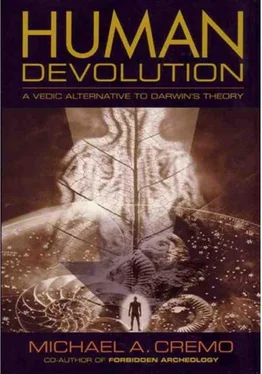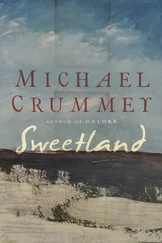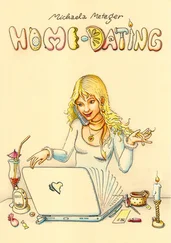Michael Cremo - Human Devolution - A Vedic Alternative To Darwin's Theory
Здесь есть возможность читать онлайн «Michael Cremo - Human Devolution - A Vedic Alternative To Darwin's Theory» весь текст электронной книги совершенно бесплатно (целиком полную версию без сокращений). В некоторых случаях можно слушать аудио, скачать через торрент в формате fb2 и присутствует краткое содержание. Год выпуска: 2003, ISBN: 2003, Издательство: Torchlight Publishing, Жанр: Старинная литература, на английском языке. Описание произведения, (предисловие) а так же отзывы посетителей доступны на портале библиотеки ЛибКат.
- Название:Human Devolution: A Vedic Alternative To Darwin's Theory
- Автор:
- Издательство:Torchlight Publishing
- Жанр:
- Год:2003
- ISBN:9780892133345
- Рейтинг книги:4 / 5. Голосов: 1
-
Избранное:Добавить в избранное
- Отзывы:
-
Ваша оценка:
- 80
- 1
- 2
- 3
- 4
- 5
Human Devolution: A Vedic Alternative To Darwin's Theory: краткое содержание, описание и аннотация
Предлагаем к чтению аннотацию, описание, краткое содержание или предисловие (зависит от того, что написал сам автор книги «Human Devolution: A Vedic Alternative To Darwin's Theory»). Если вы не нашли необходимую информацию о книге — напишите в комментариях, мы постараемся отыскать её.
Human Devolution: A Vedic Alternative To Darwin's Theory — читать онлайн бесплатно полную книгу (весь текст) целиком
Ниже представлен текст книги, разбитый по страницам. Система сохранения места последней прочитанной страницы, позволяет с удобством читать онлайн бесплатно книгу «Human Devolution: A Vedic Alternative To Darwin's Theory», без необходимости каждый раз заново искать на чём Вы остановились. Поставьте закладку, и сможете в любой момент перейти на страницу, на которой закончили чтение.
Интервал:
Закладка:
Myers’s personal research centered on the immortality of the conscious self. He gave evidence for this in his two volume study Human Personality and its Survival of Bodily Death (1903). Myers (1903 v.1, p. 24) believed that once we accept the existence of extrasensory perception it naturally will follow, by a progressive chain of evidence and reasoning, that this ability “is exercised by something within us which is not generated from material elements, nor confined by mechanical limitations, but which may survive and operate uninjured in a spiritual world.” In Human Personality , Myers therefore began his progression of evidence with psychic phenomena such as telepathy, centered in the individual consciousness. He then gave evidence of phantasmal projection— cases in which people see apparitions of living persons. He then moved to death moment apparitions, and then to apparitions or communications with the dead. for each category of phenomenon, Myers gave many well documented examples. for the purposes of the present discussion, which centers on demonstrating the existence in connection with the human organism of a mind element that can act in ways not explained by our current laws of physics, we will concentrate on his evidence for telepathy, phantasmal projections, and death moment apparitions. Evidence for apparitions of the dead and communications with the dead relate more to the existence of a conscious self apart from the body, a topic we will consider in chapter 8. Some of Myers’s research into apparitions of the living was carried out with fellow SPR researchers Edmund Gurney and frank Podmore. Their results were published in Phantasms of the living (Gurney et al. 1886). Let us now consider some representative cases.
Early in the morning of november 2, 1868, in India, Mr. R. v. Boyle had a vivid dream. He was standing in the doorway of a house in Brighton, England. He saw his father-in-law, William Hack, lying on a bed, with his (Hack’s) wife standing silently beside him. Boyle was certain that his father-in-law was dead. He woke up briefly. When he slipped again into sleep, he experienced the same dream. He was so struck by the clarity of the dream that he recorded it in his diary. fifteen days later, Boyle received a telegram from England stating that his father-in-law had died on november 1 at Brighton. William Hack was 72 years old at the time of his death, but there had been no news of any danger to his health received by Boyle or his wife in India. The time of Boyle’s dreams in India corresponded to the night of november 1 in England. SPR member Edmund Gurney confirmed Boyle’s diary entry (Myers 1903, v.1, pp. 138–139).
On december 18, 1883, M. T. Meneer, principal of Torre college, at Torquay, England, told of an event that had taken place twenty six years before. At that time, his wife’s brother, Mr. Wellington, had been living in Sarawak with Sir James Brooke, the British adventurer who became the country’s ruler, or Raja. One night, Meneer’s wife awoke and told him of a terrifying dream. Meneer stated, “She saw her headless brother standing at the foot of the bed with his head lying on a coffin by his side.” Later that night, she had the same dream. After some time, news reached England that Mr. Wellington had been killed and decapitated during a revolt against Brooke by the chinese in Sarawak, who apparently mistook Mr. Wellington for Brooke’s son. The head alone was recovered for burial. Meneer stated, “I computed the approximate time, and found it coincided with the memorable night to which I have referred” (Myers 1903, v.1, pp. 424–425). SPR member Henry Sidgwick interviewed Meneer, who told him that his wife had no reason to suspect her brother would be in any danger (Myers 1903, v. 1, p. 425).
On a Sunday night in november 1881, Mr. S. H. B. attempted to project an image of himself into the presence of two young ladies known to him, Miss L. S. verity, 25 years old, and Miss E. c. verity, 11 years old. At the time of the attempt, they were sleeping in their bedroom on the second floor of a house at 22 Hogarth Road, Kensington, in London. Mr. B. was at that time living at 23 Kildare Gardens, about three miles from the house where the girls lived. Mr. B. did not mention his planned experiment to either of the young ladies. In fact, he only decided on it after he had retired on that Sunday night. At one o’clock in the morning, he made his attempt. Mr. B. noted: “On the following Thursday I went to see the ladies in question, and, in the course of conversation (without any allusion to the subject on my part), the elder one told me, that, on the previous Sunday night, she had been much terrified by perceiving me standing by her bedside, and that she screamed when the apparition advanced towards her, and awoke her little sister, who saw me also. I asked her if she was awake at the time, and she replied most decidedly in the affirmative, and upon my inquiring the time of the occurrence, she replied, about 1 o’clock in the morning. This lady, at my request, wrote down a statement of the event and signed it” (Gurney et al. 1886, v. 1, p. 105).
Here is the statement of Miss L. S. verity, dated January 18, 1883: “On a certain Sunday evening, about twelve months since, at our house in Hogarth Road, Kensington, I distinctly saw Mr. B. in my room, about 1 o’clock. I was perfectly awake and was much terrified. I awoke my sister by screaming, and she saw the apparition herself. Three days after, when I saw Mr. B., I told him what had happened; but it was some time before I could recover from the shock I had received, and the remembrance is too vivid to be ever erased from my memory” (Gurney et al. 1886, v.1, p. 105).
One of the authors of Phantasms of the living carefully interviewed the verity sisters and learned that Miss L. S. verity had absolutely no history of hallucinations. He also confirmed her account of the apparition from Miss E. c. verity. Another sister, Miss A. S. verity clearly recalled her two sisters telling her of the strange appearance of Mr. B. in their room, in evening dress, at one o’clock. The writer of the report also said of Miss L. S. verity that “she has no love of marvels, and has a considerable dread and dislike of this particular form of marvel” (Gurney et al. 1886, v. 1, p. 105).
In february of 1850, Mrs. Georgiana Polson was attending an evening party at her home, Woolstone Lodge, in Woolstone, Berkshire, England. She went upstairs to give some instructions to her maid, regarding the duties of another household servant, a girl from cornwall. Mrs. Polson later recalled, “As I reached the top of the stairs a lady passed me who had some time left us. She was in black silk with a muslin ‘cloud’ over her head and shoulders, but her silk rustled. I could just have a glance only of her face. She glided fast and noiselessly (but for the silk) past me, and was lost down two steps at the end of a long passage that led only into my private boudoir, and had no other exit. I had barely exclaimed ‘Oh, caroline,’ when I felt she was a something unnatural, and rushed down to the drawing-room again, and sinking on my knees by my husband’s side fainted, and it was with difficulty I was restored to myself again” (Gurney et al. 1886, v. 2, p. 178). caroline (Mrs. Henry Gibbs) was a cousin of Mrs. Polson. She had stayed at the Polson house a few days before, and Mrs. Polson had begun writing a letter to her but had not finished it.
The next morning, Mrs. Polson learned that her cornish maidservant had also seen the apparition. A member of the household informed Mrs. Polson that girl had seen “a lady sitting near her, in black, with white all over her head and shoulders, and her hands crossed on her bosom.” The following morning, Mr. Tuffnell, a neighbor residing in Uffington, near faringdon, came to visit. Upon hearing of the apparition, Mr. Tuffnell wrote an account in his notebook, and advised Mrs. Polson to inquire after her cousin’s health. She wrote immediately to an uncle, the Reverend c. crowley, of Hartpury, near Gloucester, and received a reply that “caroline is very ill at Belmont and not expected to live.” Mrs. Polson later learned that caroline had in fact died “on the evening she paid me that visit.” That was february 16, 1850, as mentioned in an obituary in the times of London (Gurney et al. 1886, v. 1, p. 178).
Читать дальшеИнтервал:
Закладка:
Похожие книги на «Human Devolution: A Vedic Alternative To Darwin's Theory»
Представляем Вашему вниманию похожие книги на «Human Devolution: A Vedic Alternative To Darwin's Theory» списком для выбора. Мы отобрали схожую по названию и смыслу литературу в надежде предоставить читателям больше вариантов отыскать новые, интересные, ещё непрочитанные произведения.
Обсуждение, отзывы о книге «Human Devolution: A Vedic Alternative To Darwin's Theory» и просто собственные мнения читателей. Оставьте ваши комментарии, напишите, что Вы думаете о произведении, его смысле или главных героях. Укажите что конкретно понравилось, а что нет, и почему Вы так считаете.












